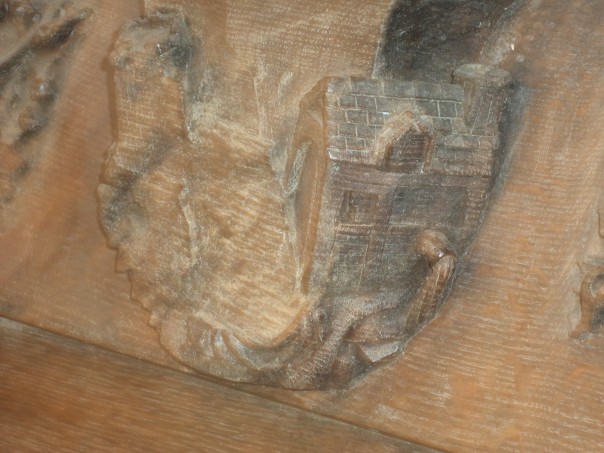I think I will start with Professor Peter Brown’s lecture from last night when he gave a masterful account of Canterbury’s literary history between 1340 and 1420, a period that witnessed Geoffrey Chaucer’s The Canterbury Tales, of course, but also much more. Among the works alluded to were Michael of Northgate’s Ayenbite of Inwit (1340), a translation into Kentish dialect of a French treatise on how to avoid sin and cultivate virtue that was aimed at lay people. Whether he was the translator or was copying it, perhaps even for those he knew in the parish of St Mary Northgate, close to his home at St Augustine’s Abbey, remains a moot point, but does indicate a desire to inform and educate his kinsfolk and former neighbours.

One of the misericords at Eastbridge Hospital, Canterbury (ex Holy Cross church)
Apparently depicting a watermill, the archbishop’s Westgate mill perhaps, it demonstrates among other things the value and complexity of the visual – issues of patronage, jurisdiction and benevolence
Another monk at the abbey, William Thorne was even busier later in the century and his chronicle provides, amongst other things, a report of the activities of the 1381 rebels in the city. Jean Froissart’s account of his visit to Becket’s shrine in 1395 in his Chroniques, although certainly not as violent, does highlight his unease in that after an absence from England for several decades he finds much has changed and he feels a stranger. Such feelings might have worried the Cathedral monks because they wished to attract pilgrims not alienate them, and in the run-up to the 1420 Jubilee of St Thomas they apparently employed considerable resources to be as welcoming as possible. Again the written word was the chosen tool and in the Prologue to The Tale of Beryn, a clever continuation of Chaucer’s pilgrim tale where the pilgrims arrive in Canterbury, they book into The Cheker of the Hope, an inn that ‘many a man did know’ and which was owned by these same monks, before setting off for the final stage of their pilgrimage. Nor was this the only text because several open letters extolling the virtues of such pilgrimages were strategically nailed up in London, Canterbury and on the way, which seemingly had the desired effect if anything like the numbers of pilgrims said to have flocked to the shrine actually did so. Even though not all these various works were in Middle English, the mother tongue of the vast majority of people in England at this time, albeit in different dialects, Professor Brown did stress the importance of what may be seen as the growth and flowering of literary texts in this vernacular nationally, as well as in Canterbury. Yet Canterbury and Kent are important in such developments, whether we are looking at the construction of custumals (by-laws) at the Cinque Ports from the early 14th century, as Dr Justin Croft has discussed in his unpublished doctoral thesis; or studies on monastic libraries and book keeping, such as Dr Paul Lee’s book on the Dominican nunnery at Dartford; or Dr James Gibson’s Records of Early English Drama volume on the diocese of Canterbury (soon to be followed by Rochester), where it is clear even parishes and small towns were able to fund and organise plays that presumably meant the production and copying of dramatic texts in English, which could be read by growing numbers of people in these late medieval Kentish communities. Such developments would seem to place Kent in the vanguard of literary and book culture in the Middle Ages, and these cultural features of the lives of Kentish men and women did not stop at the Reformation. Rather, as Dr Claire Bartram has shown, the Protestant gentry, as well as those somewhat below them socially – leading townsmen and yeomen – were keen to embrace the advantages of printing and to proclaim their great cultural heritage from the Anglo-Saxons now that the ‘Roman yoke’ had been thrown off. Dr Bartram will be among the speakers at the conference on 28 March where, as she says, ‘I will revisit Joan Thirsk’s work on agricultural texts. Professor Thirsk was among the first to promote the rich potential of this kind of practical literature and it remains an understudied area of scholarship. Taking Kent as its focus, my paper considers a number of Elizabethan print and manuscript works including Barnabe Googe’s translation of Heresbach’s ‘Four Books of Husbandrie’ and Reginald Scot’s ‘Pefite Platforme of a Hoppe Garden’. It explores what these works reveal about the book as a mechanism for social interaction in provincial society and how these writings promoted spiritual and social reform at a local level that responded to nationalist imperatives apparent in the period.’ Claire will be joined in this section of the conference by Dr Andy Kesson, whose work on John Lyly and the London stage will again show just how influential Canterbury was in the flowering of literature and drama in the early modern period, as witnessed by the richness of the Elizabethan theatre. Thus these scholars are pushing forward a wide range of exciting and important ideas that will enlarge our understanding of the role of the written (and printed) word in history.
 Centre for Kent History and Heritage
Centre for Kent History and Heritage Sheila Sweetinburgh
Sheila Sweetinburgh 776
776

